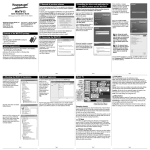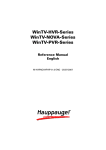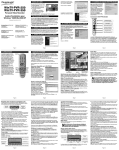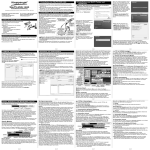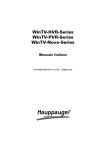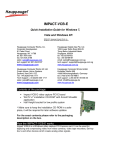Download Hauppauge WinTV-HVR-900
Transcript
N ote: If you do not receive channels using the portable antenna, try connecting a rooftop aerial to the device and scan again, if channels are now received there may be an issue with signal strength/quality in your area you may not be able to use the small antenna. WinTV-HVR-900 ©Hauppauge Computer Works, Inc. 2008 · QI-WINTV-HVR900-V2.0-ENG · 2008/01/25 Hauppauge Computer Works, Ltd. 10 Borough High Street Bank Chambers London, UK, SE1 9QQ www.hauppauge.co.uk Tech Support: (+44) 0207 378 0202 Telephone: (+44) 0207 378 1997 Fax: (+44) 0207 357 9171 [email protected] Contents of this WinTV-HVR-900 package ● ● ● ● WinTV-HVR-900 Hybrid stick USB extension cable WinTV-Installation CD-ROM including the following: · WinTV application v6 with SoftPVR™ · WinTV-Scheduler · 7 Day EPG · VTPlus This installation guide ● ● ● You can also connect sources via the A/V input cable (available on some models of WinTV-HVR-900). Plug the A/V input cable into the small connector on the side of the WinTVHVR-900 Connect your source using either the Composite or S-Video connection and the audio mini-jack connector. ote: Unless stated, most videorecorders and Set Top Boxes use only a Composite output via the SCART output. ote: During the installation, other installation wizards may open, we recommend following the instructions in each of these and installing with the default options available. ote: For advanced users you can select the 'Custom Installation' which will allow you to modify the list of applications that are installed by default. N N ote: Due to power and bandwidth requirements, we do not recommend connecting the unit into a USB Hub. 2. Turn on your PC and wait until Windows has completely started. 3. Plug the WinTV-HVR-900 stick into the USB 2.0 port. You can use the USB extension cable (available on some models) to locate the WinTV-HVR-900 a short distance from the USB slot. 1. Connecting the Aerial and A/V input cable N Insert your WinTV Installation CD-ROM, the installation window will automatically appear. N 1. Locate a free USB 2.0 port (normally located at the side or back on the computer). Audio/Video input cable Portable TV antenna IR remote control transmitter and batteries ote: If you have any anti-virus software enabled, please disable it during the installation of the software. Next, click on Step 2: Install WinTV and select your language from the list. The setup window should appear and begin to automatically install the WinTV applications. N 2. Installing the WinTV-HVR-900 Options available on certain models: N When you attach the WinTV-HVR900, the Found New Hardware Wizard will appear. Click on Cancel. Connecting an external A/V source Quick Installation Guide 3. Install the WinTV Drivers and Applications ote: If the autorun does not start, browse to the files on the disc and double click on the file called 'Setup'. In the installation window click on Step 1: Install WinTV Drivers. A blue screen will open which will begin installing and updating the drivers for your product. Once the WinTV installation is complete, click OK then Exit in the window "Hauppauge WinTV Installation CD". You should now be back at your Windows desktop. N ote: If you plug the device into a different USB socket, you may need to reinstall the WinTV-HVR-900 driver, but you will not need to reload any WinTV applications. Connecting an antenna or set top box Once complete, a message appears in the bar. If this message is Drivers have been updated Successfully, click on the bar to exit. If the message reports an error, check the connection of your WinTV, or contact our technical support. Plug your TV antenna or RF output from your cable/satellite box into the WinTV-HVR-900’s TV Connector. For digital TV reception, it is recommended to connect to a roof top aerial as this may provide a better signal quality then the portable antenna provided on some models of WinTV-HVR-900. You will need to ensure that you are located in a area that has Digital Terrestrial coverage. Please visit in the U.K.: www.dtg.org.uk/retailer/coverage.html In Sweden: www.teracom.se In Finland: www.digitv.fi In Denmark: www.digi-tv.dk In Poland: www.emitel.pl Page 1 Page 2 4. WinTV® application v6 Using a external A/V source To start the WinTV application, double click on the WinTV icon. When you run WinTV for the first time, a message will appear asking you to scan for tuner channels now; please ensure that the TV antenna is connected, click YES. Pref button Watch TV If you are using a external source like a Hi-8 Camcorder, Video recorder etc, then you will need to connect via the SVideo/Composite for the Video picture and Line-Input for the sound. N ote: Unless stated, most VCR's and STB's only output in composite video via SCART'. A SCART to S-Video lead, in most cases, will not work correctly and will only yield a black and white picture. If you are using a Scart to composite (RCA Yellow phono) lead, please ensure that the signal is being sent in the correct direction from the Scart lead to the phono connection. Configuring a external source in WinTV In the WinTV application click on Menu then Suite Manager, then click on the Sources tab. To add the S-Video or Composite channel select the option on the left and then select the Video Format from the drop down list. N Page 4 Page 3 ote: PAL BGHIDK is the commonly used format in Europe. Full screen Minimise Channel up Volume Close Channel surf Always on Top Last channel Mute Click your right mouse button in the TV window to remove toolbars. Click again to restore toolbars. Freeze picture Setup Menu CFG Configure Snapshot Snapshot viewer window: Double click on each thumbnail to see image full size.Click and hold your right mouse button to see image options. Remove toolbars no title mode Channel down Current TV channel Click your right mouse button here to see the channel selector Snapshot Still capture TV-Mode Pause Record Menu Button Playback You can change channels by using the Channel Up or Channel Down buttons on the WinTV. You can type a channel number (for example: 27) and WinTV will tune to that channel. If the entered channel does not exist, you will see a black window. You can also right click in the Current TV channel box, where you will see a list of channels. Or type letters (for example: BBC) to access to the list of the channels including these letters. When you click the Full screen TV button, TV will appear full screen on your PC monitor. When finished watching TV full screen, click your right mouse button in the TV window. If you see video with a black box around it, click the Pref button then click TV mode tab. Check the box which says “Allow resolution change”. ote: If you have attached an antenna and do not receive any digital TV channels, either use a stronger antenna (a roof top antenna is recommended for best reception) or try to add a TV channel manually (see trouble shooting section). Click Close when finished. "Always on top" Mode Type in a channel “Name” e.g. Video and a Description and then click on “Save” the channel will now be added and if you click on Close you will be returned back to the main TV viewing window. Page 5 Skip forward 10 sec Fast forward Fast rewind Pause Skip Ahead Clicking the Skip button will skip the video ahead 10 seconds. Play Fast forward Slow motion Pause Buffer The Pause buffer is space on your hard disk where video is stored during the Pause mode. The maximum amount of time which your TV program can be delayed is dependent upon how much storage space you have set for the Pause buffer. Clicking the Pause button will start recording into WinTV's Replay Buffer. It takes about 10 seconds for the Replay Buffer to be initialized and for Pause to become effective. Unclicking the Pause button will cause the audio/video program to start playing from the point where the button was originally pushed. Most WinTV functions are active while in the Pause or Pause Live mode. For example, you can change volume, resize the TV window, go into "no-title mode", etc. While in Pause mode, the Video Position bar shows the amount of the Replay Buffer which is filled with video. For example, if the Video Position indicator shows halfway, it means that half of the Replay Buffer is filled. If you find you cannot Pause as many minutes as you would like, increase the size of the Replay Buffer. While in Pause mode, the A/V stream is always saved in the Replay Buffer. To stop saving the A/V stream in the Replay Buffer, you must exit the Pause mode by clicking TV mode. Rewind While in the Pause mode, hitting the Replay button acts like the Instant Replay you see on TV broadcast sporting events: the audio/video goes back in time and you repeat what you have previously seen. Each click of the Replay button causes audio/video to go back 10 seconds. For example, if you want to repeat the audio/video you saw 10 seconds ago, you would click the Replay button once. If you want to see the video you saw one minute ago, you would need to click the Replay button six times. For extended replay times, you might find it more convenient to grab the Video Position indicator control bar and move it to the left. Once you let the control bar go, audio/video starts to play (it might take a few seconds for the WinTV application to start playing). You might have to move the Video Position indicator to the left and right to find the desired spot to start replaying audio/video. Page 9 Stop Clicking the Stop button will stop the video you are recording or playing back. Play Clicking the Play button will playback from disk the last video file created. When playing a video, you can rewind, fast forward, replay 10 sec or skip forward 10 sec using the buttons on the control bar. Pause Clicking the Rewind button while playing video will rewind the recorded video. Clicking the Rewind button again will continue the playing. TV Mode One Touch Pause One Touch Record The Pause button prepares the WinTV pausing live video. The Record button will start a record session. If you click Record button more than once, a record timer will be set and the recording will be done for 15 minutes for each time the Record button is clicked. For example, if you click the button 3 times, the WinTV will record for 30 minutes. Pause mode The pause mode allow you to pause the Live TV picture and allows you to use the TimeShift function to rewind and fast forward the TV. Clicking the Pause button on the WinTV application starts the Pause mode. The Pause Menu will drop down. Page 8 Keyboard shortcuts Sound up Sound downPlus (+) Minus (-) Ctrl T Ctrl P - Page Up Page Down Chanel Up Channel Down Frame TV Frame print Ctrl+M ALT+M 0-9 Space bar Ctrl F Clicking the Pause button while Playing will pause your audio/video. Rewind Slow Motion Clicking the Slow Motion button while playing video will play in Slow Motion. Clicking the Slow Motion button again, will continue playing normally. Fast Forward Clicking the Fast Forward button one time will fast forward your video at 2X speed. Clicking the Fast Forward button two times will fast forward your video at 8X speed. Clicking the Rewind button will play the video file in reverse. Clicking the Rewind button again will continue the playing of the video. Fast Forward Clicking the Fast Foward button one time will fast foward your video at 2X speed. Clicking the Fast Foward button two times will fast foward your video at 8X speed. Clicking the button again will continue playing back at normal speed. Slow Motion Record mode Clicking the Slow Motion button during playback will cause the video to play in slow motion (at 1/2 speed). Clicking the Slow Motion button again will return the video to normal playback speed. Record File button Display Counter Video-Position File Rewind Pause Stop Play Forward Play forward slow Replay Record and Playback Page 7 While Replaying, your audio/video program continues to be recorded in the Replay Buffer. Therefore, if you have clicked the Replay button 3 times (so that you are replaying the audio/video seen 30 seconds ago), the video you see in the WinTV window will be 30 seconds behind the live program. Record Time counter Video-position The WinTV application will remain in view over any other applications even if it is not selected. To turn on, click the Always on top button. It will turn green. To turn off, click this button again. A convenient way to use Always-on-top is to make the TV window in the no-title mode small, and to make the TV window in the title mode larger. Then you can switch from a small window to a larger one by clicking the right mouse button. Page 6 Pause There are three buttons to control the watching, recording and pausing of TV. Clicking on the Pause button will cause the Pause menu to roll down from the WinTV application, while clicking on the Record button will cause the Record menu to roll down. TV Mode N TV-Mode Click the Menu button to open the TV setup menu. Here is the main control bar for TV channels, and duplicate controls for other functions: Suite Manager: Configure the TV tuner (scanning, naming, channel pre set, etc..) and setting up favourite channel lists. Configuration: Duplicate configuration menus for colour, audio, etc. View: For settings an exact TV window size: 320x240, 640x480 etc. Pause and Record Changing channels Select your country location, for instance, select United Kingdom and then, select Scan. The scanning process will start by scanning the analogue frequencies for channels, if any are found they will be added to the channel list. The scanning process for DVB-T will then scan for channels. When a DVB-T channel is found, the Signal Status will show a quality level and the locked box will be checked. The DVB-T digital channels that are found will appear in the channel listing box. Click the Pref button to open the preferences menu: View: These are the settings for the On Screen Display of the TV channel and Audio Volume, where you can enable Close Captions (if supported in your system configuration), plus controls for the Toolbar mode (Title mode), NoToolbar mode (No Title) and Full Screen (TV mode). Movies: Here is where you configure some video and audio settings. You can set the movie record directory (DVCR Record File Path). Snapshot: Set the size of your captured images, plus single or two field captures for capturing motion or still image video. Audio: Your audio settings are configured here. Clicking the Record button will automatically generate a file name and start recording your audio/video program. Functions: ● When recording TV, the record button will depressed ● A time counter will be shown indicating the lenght of time of the recording If you click Stop the time counter will revert back to 00:00:00 The time is specified in a Hour:Minute:Second format. Page 10 Clicking the File button opens the File menu. The last file recorded is listed in the File name box. In the File menu you can: ● Rename your recorded video file: To rename a video file, find the file you would like to rename, highlight it with your mouse, and click and hold the right mouse button. Go down to Rename and then you can type in a new name. Remember: you must keep the MPG extension on the file. ● Play a video file previously recorded: Find the file you would like to play, highlight it with your mouse (one click of the mouse button) and click Open. Then click the Play button. ● Delete recorded video files which you no longer want: Click your right mouse button on the video file once, go down the menu and click Delete. Page 11 Page 12 - Mute on/off Re-size TV menu Channel number Take a snapshot Still image ● 5. WinTV-Scheduler WinTV-Scheduler allows you to schedule the recording of TV shows. WinTV-Scheduler, once it is set, can be closed, and the WinTV application will “wake up” at the desired time and tuned to the desired channel. WinTV-Scheduler works by using the Windows Task Scheduler to launch WinTV at the chosen time. WinTV-Scheduler sets up a command line in Task Scheduler to run WinTV, specifying a TV channel and a length of time to record. After installation, WinTV-Scheduler can be found by going to Start / Program files / Hauppauge WinTV. To set up an event for timed watching or recording, click on the Add Program. The items that need to be set for each event are: ● Source selection: leave set at WinTV to bring up the WinTV at the requested time and on the requested channel. Select Reminder to just pop-up a text file as reminder. Time to Begin Program: set to the desired start time. The default time is about 3 minutes from the current time. Click on the hour to set the hour, the minute to set the minute to start the program. N ote: It is always possible that your TV show will be transmitted in advance or late, and it takes about 10 seconds to launch the WinTV and set up for recording. Please set the Time to Begin Progam few minutes before the time your TV show should starts. ● Program Duration: set the duration of this event, using the arrows (steps of 30 minutes) or directly the keyboard. This will update the Time to End Program window. ● Date to Begin: today's date is the default. Change this if you want to schedule on another date. ● Program Period: One Time Only, Every day or Weekly are the choices. If you select the Weekly option, select the day you would have the show recorded too. ● Date to End: If you have selected the Every Day or Weekly option, you can specify the date at which it will stop this task. ● Channel selection: choose one of your scanned channels. ● Recording options: click on Record to File to record your show. Leave this button unchecked to watch TV at the requested time. You can also name your file to record. Once these are set, click Set Program. You can add more Events, clicking Set Program after each event is set. When you are finished click Close. 6. The 7 Day EPG What is 7 Day EPG for WinTV Certain digital DVB-T channels, along with their TV programmes, contain a TV channel guide. This guide is a listing of the programs being shown for the next 7 days, and includes the TV programme name, programme start times and length. The 7 Day EPG for WinTV extracts TV guide data from a DVB-T channel which contains this data. It creates a database on your computer. When the Hauppauge 7 Day EPG opens up with its chart of times and TV programs, it reads the EPG database and formats the 7 Day EPG guide window. If you would like to record one of these TV programmes listed in the 7 Day EPG for WinTV window, you simply click the "Record" button and at the correct time your TV show will be recorded on your PC. 2. Select Open Client Tool to see the EPG Service window: It shows the status of the EPG service. The buttons below the window give you the following controls: • Start/stop the EPG Service • Modify the current settings • Open the EPG help file • Exit the EPG application To view the EPG guide click 'View EPG' See Step 4 for more information. How to use 7 Day EPG for WinTV 1. You should see an icon of a globe close to the Windows clock. Right click on this icon to give a list of options. 3. Viewing the EPG information From the EPG application window, click 'View EPG' this will open a web page showing the EPG information, initially the application will need to scan and update the EPG information. The amount of time it takes to read the data is related to the number of channels in your DVB-T transmission area. The more channels, the longer it takes to read all of the data, this may take several minutes: N ote: You cannot access the Wing settings until you have purchased the optional transcoder software, for more informations see www.hauppauge.com/wing. Please refer to the Wing manual for information on using the Wing settings. The WinTV program does not have to be running for the Schedular to work, but you PC need to be turn on. If WinTV is not running, it takes about 10 seconds to start WinTV and to start the recording of TV. Page 13 Once the scanning is complete you will be able to see the EPG guide: Page 14 7. Installing the Remote Control (on some models) The WinTV’s remote control software is installed automatically during the installation of the WinTV applications. The installation will add the shortcut “AutoStart IR” to the Start-up group. If this is not the case, you can manually install the WinTV’s remote control software from the installation CD-ROM / IR32 folder. Double click on IR32.exe. 1. Insert the batterie into the the Infrared Remote control. 2. Ensure the IR icon is on the start bar - IR.exe is loaded when Windows starts only if your WinTV is connected. N ote: If you don’t see the WinTV Remote icon in the system tray or if you need to reset the remote control application, select “Restart IR” from the Start / All programs / Hauppauge WinTV directory. You should restart the IR program each time you plug your WinTV – except if it was plugged before Windows started. Checking the function of the IR Remote 4. Scheduling a recording To schedule a recording, simply click on the Program title, this will give you more information about that program, from there you can click on 'Schedule for recording', When you click a "record" button, the 7 Day EPG schedules a task to record your TV show from a DVB-T channel. The scheduled task is added to Windows Scheduled Tasks. N ote: You need to have a user name and password on your PC in order for the scheduled recordings to record through Windows Sheduled Tasks. Make sure you see the black remote icon in the system tray (the area next to the clock in the taskbar). Point the Remote transmitter at the Remote control receiver (the little eye on your WinTV Stick) and press the “Go” button. This should open the “WinTV Remote” menu. Press the “OK” button to start WINTV.EXE or use the “Up” and “Down” arrows on the remote to select another option. N ote: The WinTV application only responds to the remote control if it is the active window. If the WinTV application is not the active Window, press the TV button on the remote to bring the WinTV window into the foreground. N ote: If you have a Windows Media Center PC and you do not have a Media Center Remote you can use the Hauppauge Remote instead (the remote is not Media Center certified and some functionality may not be available). N ote: The credit card sized remote can be stored in a laptop's PCMCIA bay while not in use. The scheduled recordings can be viewed and modified through the WinTV-Scheduler. The format of the file name is [Programme title]_[Time]_[Date].mpg Page 17 To uninstall the Driver and Software To uninstall the software simply run hcwclear.exe from the installation CD-ROM and select the last 2 options 'remove all WinTV drivers and applications (total removal)' and 'search all INF files'. If you now select OK a black screen will briefly appear and once it has disappeared the software will be removed. If you now re-start the computer you will be at Step 3 on page 3 of this document and can now reinstall the software. Only some channels are found during DVB-T channel scan Check if there are transmitter works on your local transmitter here: www.bbc.co.uk/reception/transmitters/today.shtml as this could effect the reception of certain channel. Adding a TV channel manually If the scan did not succeed, you can add a channel manually by entering the LCN number for your local transmitter. Enter your post code in this link: www.wolfbane.com/cgi-bin/tvd.exe? to be presented with information on your local transmitters. N ote: Your local transmitter should be the closest transmitter with a H in the 'Pol' column. You need to write down the LCN numbers. Remote Control Buttons When watching live TV Go: Open the “WinTV Remote” menu, allowing you to start the WinTV application Power: Exit the WinTV application TV: Bring WinTV to the foreground (if not currently active) / Full screen TV mode on/off Arrows & OK: Select and confirm options in the WinTV Remote menu or the Windows task list. Back/Exit: Stop a recording / Exit pause mode and close the Pause/Record tray (as the Stop button) Menu: Brings up the Windows task list. Use the left and right arrows to change to other Windows tasks, and click OK. Menu is an always active button. Vol+ and Vol-: Control the audio volume Mute: Audio on/off Ch+ and Ch- buttons: Select the next/previous channel Prev.Ch: Swap to last viewed channel Record button: Open the Pause/Record tray & start a recording. See section Remote Control Buttons during a Recording Stop button: Stop a recording / Exit pause mode and close the Pause/Record tray (as the Back/Exit button) Play button: Open the Pause/Record tray & play back the last recording. If you didn’t record any TV shows recently, it will open the MyVideos folder. See section Remote Control Buttons during Pause TV or Playback << (Rewind): Swap between Title and No-Title mode >>: Turn to Full screen TV mode Pause button: Open the Pause/Record tray & pause live TV (pause mode). Clicking again will play from the point where the button was originally pushed 0-9: Direct access to channel number Text (*): Start VTPlus teletext application (if installed) Page 18 TV display has problems (e.g. no picture but with sound or blurred image) Troubleshooting With the WinTV application closed click on the WinTV program group (Start / Programs / Hauppauge WinTV) there is a utility called “Primary”. Within Primary, select a different option from the main list of four items (Allow VMR/Allow Overlay/Force Primary/DIB Draw), close the application using the X in the top right hand corner then restart the TV program. Repeat this process for all four options to determine the best option for your computer. “Error code 10” during installation This is caused by a failure to load the WinTV-HVR drivers. Uninstall the software (as above) and then follow the instructions from page 3. If this still give you an error message move the WinTV-HVR-900 to a different USB port and re-install the drivers again. Under Windows XP Media Center application, I get the error message “Decoder Error” This message is normally caused by missing or incorrectly installed MCE compatible DVD Decoder software. Please insure you have the latest MCE compatible DVD Decoder from one of the following recommended vendors: Cyberlink, Nvidia, Intervideo. Under the Media Center application I am unable to setup my TV from analogue source. This problem occurs as the WinTV-HVR-900 does not have a built in hardware encoder which is required by MCE, you will need to install the MCE Soft Encoder from our installation CD-ROM or software download. Page 16 Page 15 Page 19 FCC Statement Radio Interference Statement: WinTV have been tested and found to comply with the limits for a Class B digital device, pursuant to part 15 of the FCC Rules. These limits are designed to provide reasonable protection against harmful interference in a residential installation. This equipment generates, uses, and can radiate radio frequency energy and cause harmful interference to radio communications. However, there is no guarantee that interference will not occur in a particular installation. If this equipment does cause harmful interference to radio or television reception, which can be determined by turning the equipment off and on, the user is encouraged to try to correct the interference by one or more of the following measures: ● reorient or relocate the receiving antenna. ● increase the separation between the equipment and receiver. ● connect the equipment into an outlet on a circuit different from that to which the receiver is connected. ● consult the dealer or an experienced radio/TV technician for help. FCC ID: H90WINTV CAUTION: Changes or modifications not expressly approved by the party responsible for compliance to the FCC Rules could void the user's authority to operate the equipment. CE Statement: This equipment has been tested and complies with EN 55013, EN 55020 and IEC 801-3 part 3 standards. Remote Control Buttons during a Recording N ote: Most WinTV functions and remote buttons are disabled when recording Record button: Set the duration of the recording, by steps of 15 minutes up to 2 hours, then by steps of 30 minutes up to 4 hours. Clicking again will disable recording duration. This information is displayed in the Pause/Record tray. Stop button: Stop recording and close the Pause/Record tray (as the Back/Exit button) Pause button: Freeze the video. Press the Play or Pause button again to unfreeze the video. The Pause button has no effect on the recording itself. While the video is frozen, the recording is continued in the background, there is no Rewind, Forward, Skip, Replay function. Remote Control Buttons when Pausing TV or Playing a Video N ote: You cannot change channels when Pausing TV Record button: Stop current action and start a recording Stop button: Stop playing or Exit pause mode and close the Pause/Record tray (as the Back/Exit button) Play button: Play the recorded TV or TV from the pause buffer (if Pause/Record tray opened). Play and Pause button have alternatively the same function. << (Rewind): Play backwards at 8x speed. Clicking again will play paused TV or recorded TV at 1x >> (Forward): Play forward at 2x speed. Clicking again will play forward at 8x, then back to 1x Pause button: Start Pause-Mode (TimeShift). Press Play or Pause again to continue watching from where you left off >I (Skip): Skips ahead in the Pause buffer by 10 seconds per click. Holding the Skip button will auto-repeat, and advances the video about 10 minutes per 15 seconds the button is depressed I< (Replay): Skips backward in the Pause buffer by 10 seconds per click. Holding the Replay button will auto-repeat, and advances the video about 10 minutes per 15 seconds the button is depressed Quick Jump 0 to 9 buttons: When playing a video, you can quickly skip through the video by pressing the 0-9 buttons. When you press one of these buttons, you will skip to, for example, 10% of the video file when you press '1', 20% of the video file when you press '2' and so forth (% of the length of the file). During Pause-Mode, any key skips ahead in the Pause buffer to -2 seconds. Page 20 Waste Electrical and Electronic Equipment (WEEE) The device may not be disposed of with household rubbish. This appliance is labeled in accordance with European Directive 2002/96/EG concerning used electrical and electronic appliances (Waste Electrical and Electronic Equipment - WEEE). The guideline determines the framework for the return and recycling of used appliances as applicable throughout the EU. To return your used device, please use the return and collection systems available to you. In the WinTV Channel Manager, click on Sources then DVB-T Source, enter the LCN numbers into the space under Channel Number and click on the Tune button. The channel number will then be scanned and any channels found will be listed in the channel list below. Page 21 Page 22 Page 23 Page 24


